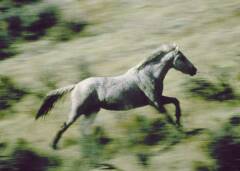Feral
A feral animal or plant is one that has escaped from domestication and returned, partly or wholly, to its wild state.
Applicability
Animals
A feral animal is one that has reverted from the domesticated state to a stable condition more or less resembling the wild.
Plants
Domesticated plants that revert to wild are usually referred to as escaped, introduced, or naturalized. However, the adaptive and ecological variables seen in plants that go wild closely resemble those of animals.
Variables
Susceptibility
Certain familiar animals go feral easily and successfully, while others are much less inclined to wander and usually fail promptly outside domestication.
Degree
Some species will detach readily from humans and pursue their own devices, but do not stray far or spread readily. Others depart and are gone, seeking out new territory or range to exploit and displaying active invasiveness.
Persistence
Whether they leave readily and venture far, or not, the ultimate criterion for success is longevity. Can they establish themselves and reproduce reliably in the new environment?
Tenure of Domestication
Neither the duration nor the intensity with which a species has been domesticated offers a useful correlation with its feral potential.
Examples
- The goat is one of the oldest domesticated creatures, yet readily goes feral and does reasonably well on its own.
- The cat returns readily to a feral state if it has not been socialized properly in its young life. It will usually fear humans and people often unknowingly own one and think it merely "unfriendly." These cats, especially if left to proliferate, are frequently considered to be "pests" in populated neighborhoods, and may be blamed for decimating the bird population and digging up people's yards. They are desirable to keep rodent and snake populations down in agriculture. Such cats are often referred to as "barn" cats. A local population of feral cats living in an area and using a common food source such as food scavenged from dumpsters or supplementary feeding by humans is called a feral cat colony. Kittens learn to be feral from their mothers or through bad experiences. Kittens under six months of age can be socialized (see socialization), while cats older than six months are very hard to socialize. Animal shelters may foster the kittens to be socialized but sometimes kill them outright. The feral adults are often killed or euthanized due to the difficulty of socializing them to the point of adoptability. More recently, the "Trap-Neuter-Return" method has been used in many locations as a means of humanely managing the feral cat population.
- Sheep are close contemporaries and cohorts of goats in the story of domestication, yet they have little initiative and even less competence.
- Cattle have a medium-long history under human domination, and do well enough on open range for months or even years with little or no supervision. Their ancestors the Aurochs were indominable, on par with Cape Buffalo, and even feedlot cattle display traces of this past. Although they had plentiful opportunity in North America, they failed to established any long term independence. Perhaps they were too valuable not to be rounded up and recovered, or maybe in kind with grizzlies, their vestigal Bos primigenius confidence did not serve well against humans.
- The horse became a legendary and spectacular feral invader of the American continent. Indications are that it escaped, spread, and thrived from the earliest introductions, and did so repeatedly. It has a medium-long history of domestication. It is known there as a mustang.
- The pig was free-ranged with other animals by pioneers and settlers. Across the Southern tier and Mid-western regions of North America there are multiple highly tenacious populations descendant from escapees, mixed in places with released wild European swine. They have been hunted, shot on sight, tracked with dogs, trapped and even poisoned. Likewise in Europe, the French harvest about 10,000 swine per year as wild game (also possibly mixed wild-feral), and recently a large city park within urban Paris was disrupted and closed for months while wildlife officials struggled to evict, shoot or trap a boar that had claimed the refuge for his own.
- Pigeons were formerly kept for their meat.
- Dogs can revert to wildness, becoming predators little less effective than the Big Cats of like size. In Antarctica, dogs abandoned at the end of explorations surevived by preying upon penguins. Feral dogs often lack the fear of humans that wild wolves show; their cunning, power, size, strength, amd agility cause them to approach the destructiveness of livestock and danger to humans.
Conclusions
The difficulties of defining the nature of and predicting the properties of species that undergo domestication, even after the fact, are themselves intractable. It appears that doing the same for feral development includes all the baggage of domestication, plus additional complications.
Some heavily dominated and selected species remain ready, willing and able to bolt for freedom, and strive impressively to retain it, while others that are only lightly domesticated and seem like good candidates for successful flight and invasion perform weakly.
Outstanding questions about the feral state include:
- What are the differences between a fully established feral population and its domestic ancestors?
- Are feral populations of long standing comparable with the pre-domestication species, or with other never-domesticated animals?
- Do feral resources always offer good re-domestication prospects, i.e., do they retain the core goal traits of captivity?
See Also
External Links
Note: Links that treat feral animals as a mere pest issue are the norm.
- National Wild Horse and Burro Program
- "There are probably at least 300,000 feral camels in Australia..."
feral camels - Alley Cat Allies, a feral cat advocacy organization

